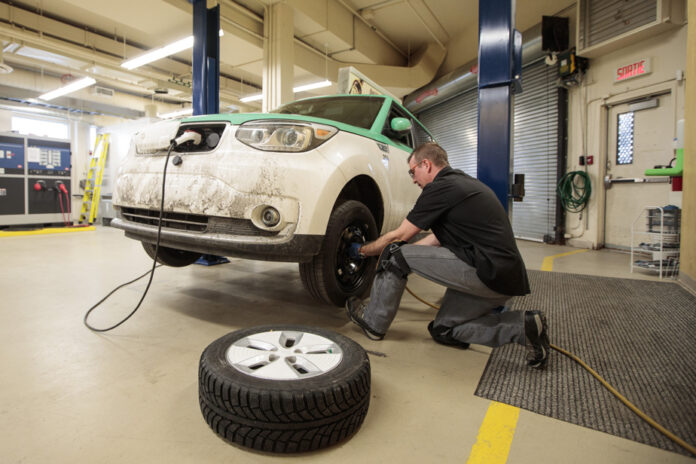Faced with the apparent simplicity of their compact mechanics powered by electrons, many consumers believe that electric vehicles require no (or little) maintenance. The reality, however, is much more nuanced. Pierre Henry, trainer at Atelier Branché, a mechanical training center for electric vehicles located in Saint-Hubert, helped us see things more clearly.
Sure, an electric vehicle doesn’t have spark plugs, a timing chain, or a turbocharger that can wear out and stop working, but some of its components require special attention. “An electric car requires on average 23% less maintenance than a gasoline car,” estimates Mr. Henry in an interview with La Presse. A proportion that might surprise more than one person, but which makes sense when you look at the basics of its maintenance.
The experienced trainer first highlights a problem commonly associated with electric automobile brakes due to their low use. “One-pedal” driving, appreciated by many electric vehicle owners, allows both energy to be stored when decelerating and the car to slow down without using the brake pedal, which leads to underuse of the brake pedal. braking system. “Rust often gets into the brakes,” Mr. Henry cautions, while advising annual maintenance of the calipers to prevent them from seizing, in addition to a periodic change of the brake oil, which can become contaminated with the weather.
The cooling system is another element that should not be neglected on an electric vehicle. Playing an essential role in the thermoregulation of the battery and, therefore, its performance, it is significantly more complex than that of a traditional gasoline car. “On a Chevrolet Bolt, there are three cooling systems to maintain,” Henry illustrates. It is therefore necessary to have these systems inspected at certain intervals as a preventative measure. Replacing the coolant, according to the manufacturer’s recommendations, is also important to preserve its properties and prevent it from becoming “acidic or alkaline”. On this subject, Mr. Henry indicates that the very high cost of this fluid, particularly at Hyundai and Kia, is expected to fall due to a more varied offering thanks to the secondary market.
Other maintenance worth noting: Some electric vehicles require oil changes, maintenance that can be overlooked by some uninformed owners. The Ford F-150 Lightning and Tesla reduction gearbox is oil lubricated and has an oil filter. “This oil can deteriorate a lot,” Henry says, and the filter can corrode if not replaced periodically. The intervals are much further apart than in the case of gasoline vehicles, but it is important to replace it from time to time to ensure proper lubrication of these essential gears.
Like cars with a combustion engine, cars powered by an electric motor have a 12V battery which powers the on-board electronics. Mr. Henry encourages owners of electric vehicles to have their charge tested regularly, because the warning signs of its weakness are not as obvious as on a gasoline vehicle, which can struggle to start in such circumstances.
Being particularly heavy due to their battery, electric vehicles also cause significant stress on suspension and steering parts, a phenomenon accentuated by the deplorable state of our road network. The mechanic advises having these components, in addition to the battery and brakes, inspected at least twice a year to have peace of mind.
Due to the high torque of the electric motors, the tires can also wear out rather quickly if the driver is a little too enthusiastic. A variable that must be taken into account in the maintenance budget. That said, Henry mentions that if the ride is smooth, premature tread wear can be avoided.
Finally, the trainer is of the opinion that it is necessary to apply a good anti-rust treatment to preserve the condition of the vehicle, despite what the manufacturers say.
Mr. Henry points out that good workshops will go as far as unbolting the high-voltage battery to carry out the rust-proofing treatment.
An essential element for the proper functioning of an electric vehicle, the high voltage battery often makes the headlines due to the multiple announcements linked to the promised Quebec sector. It has also been a source of questions since its infancy due to its very high replacement costs.
Pierre Henry nevertheless wants to be reassuring about its longevity. “It’s impressive how the batteries don’t wear out,” the trainer enthusiastically emphasizes, noting that only Nissan Leafs can suffer from faster degradation due to their air-cooled system. A more pronounced problem if the vehicle has spent most of its time in a hot climate.
Mr. Henry also specifies that he has not noticed any premature wear of the batteries linked to rapid recharges: “I am not worried […], it is a false debate. » He estimates that a normal battery loses on average “2 to 3%” of its charging capacity per year while arguing that it “will often take the life of the car”. To support this assertion, he details the generous guarantees of many manufacturers.
Last advice, and not least: do not hesitate to inform yourself and follow the recommendations of specialists specific to your model to extend the life of your – expensive – purchase. There are certainly many advantages to making the transition to electric, but this must invariably be accompanied by rigorous maintenance to complete these silent kilometers with peace of mind.















